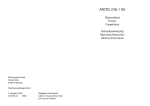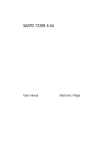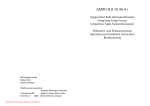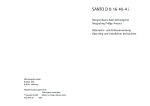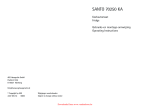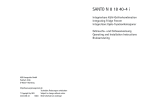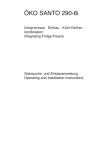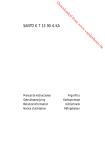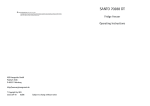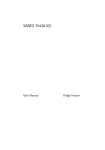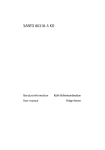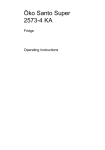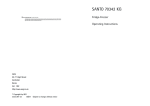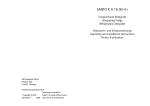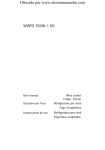Download AEG Integrating Freezer Operating instructions
Transcript
SANTO C 8 18 40-5 i Geïntegreerde dubbeldeurs-koelautomaat Integrating Fridge-Freezer Integrierbares Kühl-Gefriergerät Gebruiks-en montage-aanwijzing Operating and Installation instruction Gebrauchs- und Einbauanweisung AEG Hausgeräte GmbH Postfach 1036 D-90327 Nürnberg http://www.aeg.hausgeraete.de © Copyright by AEG 2223 403-11---01/06 Wijzigingen voorbehouden Subject to change without notice Änderungen vorbehalten Downloaded from Fridge-Manual.com Manuals Sicherheit Die Sicherheit unserer Kältegeräte entspricht den anerkannten Regeln der Technik und dem Gerätesicherheitsgesetz. Dennoch sehen wir uns veranlaßt, Sie mit folgenden Sicherheitshinweisen vertraut zu machen: Bestimmungsgemäße Verwendung • Das Kältegerät ist für die Verwendung im Haushalt bestimmt. Es eignet sich zum Kühlen, Einfrieren und Tiefkühllagern von Lebensmitteln sowie zur Eisbereitung. Wird das Gerät zweckentfremdet oder falsch bedient, kann vom Hersteller keine Haftung für eventuelle Schäden übernommen werden. • Umbauten oder Veränderungen am Kältegerät sind aus Sicherheitsgründen nicht zulässig. • Sollten Sie das Kältegerät gewerblich oder für andere Zwecke als zum Kühlen, Tiefkühllagern und Einfrieren von Lebensmitteln benutzen, beachten Sie bitte die für Ihren Bereich gültigen gesetzlichen Bestimmungen. Vor der ersten Inbetriebnahme • Überprüfen Sie das Kältegerät auf Transportschäden. Ein beschädigtes Gerät auf keinen Fall anschließen! Wenden Sie sich im Schadensfall bitte an den Lieferanten. Dear customer, Before placing your new refrigerator/freezer into operation please read these operating instructions carefully. They contain important information for safe use, for installation and for care of the appliance. Please keep these operating instructions for future reference. Pass them on to possible new owners of the appliance. These operating instructions are for use with several technically comparable models with varying accessories. Please observe the notes which apply to your model. Notes which are important for your safety or for the proper functioning of the appliance are stressed with a warning triangle and/or with signal words (Warning!, Caution!, Attention!). Please observe the following carefully. Supplementary information regarding operation and practical applications of the appliance appear after this symbol. Tips and notes concerning economical and environmentally sound use of the appliance are marked with the cloverleaf. The operating instructions contain instructions for the correction of possible malfunctions by the user in the section "What to do if ...". If these instructions should not be sufficient, our customer service department is always available to you. Kältemittel Das Gerät enthält im Kältemittelkreislauf das Kältemittel Isobutan (R600a), ein Naturgas mit hoher Umweltverträglichkeit, das jedoch brennbar ist. • Achten Sie beim Transportieren und Aufstellen des Gerätes darauf, daß keine Teile des Kältemittelkreislaufs beschädigt werden. • Bei Beschädigung des Kältemittelkreislaufs: – offenes Feuer und Zündquellen unbedingt vermeiden; – den Raum, in dem das Gerät steht, gut durchlüften. Sicherheit von Kindern • Verpackungsteile (z. B. Folien, Styropor) können für Kinder gefährlich sein. Erstickungsgefahr! Verpackungsmaterial von Kindern fernhalten! • Ausgediente Altgeräte bitte vor der Entsorgung unbrauchbar machen. Netzstecker ziehen, Netzkabel durchtrennen, eventuell vorhandene Schnapp- oder Riegelschlösser entfernen oder zerstören. Dadurch verhindern Sie, daß sich spielende Kinder im Gerät einsperren (Erstickungsgefahr!) oder in andere lebensgefährliche Situationen geraten. Downloaded from Fridge-Manual.com Manuals 46 23 Contents Inhalt Safety . . . . . . . . . . . . . . . . . . . . . . . . . . . . . . . . . . . . . . . . . . . . . . . . . . . . .25 Disposal . . . . . . . . . . . . . . . . . . . . . . . . . . . . . . . . . . . . . . . . . . . . . . . . . . .27 Appliance Packaging Information . . . . . . . . . . . . . . . . . . . . . . . . . . . . . .27 Disposal of old Appliances . . . . . . . . . . . . . . . . . . . . . . . . . . . . . . . . . . .27 Remove transport safeguard . . . . . . . . . . . . . . . . . . . . . . . . . . . . . . . . .27 Shelf holders . . . . . . . . . . . . . . . . . . . . . . . . . . . . . . . . . . . . . . . . . . . . . . .28 Installation . . . . . . . . . . . . . . . . . . . . . . . . . . . . . . . . . . . . . . . . . . . . . . . .28 Installation Location . . . . . . . . . . . . . . . . . . . . . . . . . . . . . . . . . . . . . . . . .28 Your refrigerator needs air . . . . . . . . . . . . . . . . . . . . . . . . . . . . . . . . . . . .29 Housing dimensions . . . . . . . . . . . . . . . . . . . . . . . . . . . . . . . . . . . . . . . . .29 Electrical Connection . . . . . . . . . . . . . . . . . . . . . . . . . . . . . . . . . . . . . . . .29 Prior to Initial Start–Up . . . . . . . . . . . . . . . . . . . . . . . . . . . . . . . . . . . . .29 Operating and indicator panel Fridge . . . . . . . . . . . . . . . . . . . . . . . . .30 Starting up and temperature regulation . . . . . . . . . . . . . . . . . . . . . . .30 Interior accessories . . . . . . . . . . . . . . . . . . . . . . . . . . . . . . . . . . . . . . . . .32 Fresh food refrigeration . . . . . . . . . . . . . . . . . . . . . . . . . . . . . . . . . . . . .33 Operating and indicator panel appliance . . . . . . . . . . . . . . . . . . . . . .34 Starting up and temperature regulation . . . . . . . . . . . . . . . . . . . . . . .34 Freezing and storing frozen food . . . . . . . . . . . . . . . . . . . . . . . . . . . . .37 Preparation of Ice Cubes . . . . . . . . . . . . . . . . . . . . . . . . . . . . . . . . . . . . .38 Freezing Calendar . . . . . . . . . . . . . . . . . . . . . . . . . . . . . . . . . . . . . . . . . . .38 Defrosting . . . . . . . . . . . . . . . . . . . . . . . . . . . . . . . . . . . . . . . . . . . . . . . . .38 Cleaning and Care . . . . . . . . . . . . . . . . . . . . . . . . . . . . . . . . . . . . . . . . . .39 Energy Saving Tips . . . . . . . . . . . . . . . . . . . . . . . . . . . . . . . . . . . . . . . . . .40 What to do if . . . . . . . . . . . . . . . . . . . . . . . . . . . . . . . . . . . . . . . . . . . . . .41 Correcting Malfunctions . . . . . . . . . . . . . . . . . . . . . . . . . . . . . . . . . . . . . .41 Changing the light bulb . . . . . . . . . . . . . . . . . . . . . . . . . . . . . . . . . . . . . .43 Regulations, Standards, Guidelines . . . . . . . . . . . . . . . . . . . . . . . . . . .43 Sicherheit . . . . . . . . . . . . . . . . . . . . . . . . . . . . . . . . . . . . . . . . . . . . . . . . . .46 Entsorgung . . . . . . . . . . . . . . . . . . . . . . . . . . . . . . . . . . . . . . . . . . . . . . . .48 Information zur Geräteverpackung . . . . . . . . . . . . . . . . . . . . . . . . . . . . .48 Entsorgung von Altgeräten . . . . . . . . . . . . . . . . . . . . . . . . . . . . . . . . . . .48 Transportschutz entfernen . . . . . . . . . . . . . . . . . . . . . . . . . . . . . . . . . . .48 Transportsicherungen . . . . . . . . . . . . . . . . . . . . . . . . . . . . . . . . . . . . . . . .49 Aufstellen . . . . . . . . . . . . . . . . . . . . . . . . . . . . . . . . . . . . . . . . . . . . . . . . .49 Aufstellort . . . . . . . . . . . . . . . . . . . . . . . . . . . . . . . . . . . . . . . . . . . . . . . . .49 Ihr Kühlgerät braucht Luft . . . . . . . . . . . . . . . . . . . . . . . . . . . . . . . . . . . .50 Nischenmaße . . . . . . . . . . . . . . . . . . . . . . . . . . . . . . . . . . . . . . . . . . . . . . .50 Einbau . . . . . . . . . . . . . . . . . . . . . . . . . . . . . . . . . . . . . . . . . . . . . . . . . . . .50 Elektrischer Anschluß . . . . . . . . . . . . . . . . . . . . . . . . . . . . . . . . . . . .50 Vor Inbetriebnahme . . . . . . . . . . . . . . . . . . . . . . . . . . . . . . . . . . . . . . . . .51 Bedienungs- und Kontrolleinrichtung Kühlraum . . . . . . . . . . . . . . . .51 Inbetriebnahme - Temperatur einstellen . . . . . . . . . . . . . . . . . . . . . . .52 Innenausstattung . . . . . . . . . . . . . . . . . . . . . . . . . . . . . . . . . . . . . . . . . . .54 Richtig lagern . . . . . . . . . . . . . . . . . . . . . . . . . . . . . . . . . . . . . . . . . . . . .55 Bedienungs- und Kontrolleinrichtung Gerät . . . . . . . . . . . . . . . . . . . .56 Inbetriebnahme - Temperatur einstellen . . . . . . . . . . . . . . . . . . . . . . .57 Einfrieren und Tiefkühllagern . . . . . . . . . . . . . . . . . . . . . . . . . . . . . . . .59 Eiswürfel bereiten . . . . . . . . . . . . . . . . . . . . . . . . . . . . . . . . . . . . . . . . . .60 Lagergutsymbole/Gefrierkalender. . . . . . . . . . . . . . . . . . . . . . . . . . . . . .61 Abtauen . . . . . . . . . . . . . . . . . . . . . . . . . . . . . . . . . . . . . . . . . . . . . . . . . .61 Gerät abschalten . . . . . . . . . . . . . . . . . . . . . . . . . . . . . . . . . . . . . . . . . . .62 Reinigung und Pflege . . . . . . . . . . . . . . . . . . . . . . . . . . . . . . . . . . . . . . .63 Tips zur Energie-Einsparung . . . . . . . . . . . . . . . . . . . . . . . . . . . . . . . . .64 Was tun, wenn . . . . . . . . . . . . . . . . . . . . . . . . . . . . . . . . . . . . . . . . . . . . .64 Abhilfe bei Störungen . . . . . . . . . . . . . . . . . . . . . . . . . . . . . . . . . . . . . . .64 Lampe wechseln . . . . . . . . . . . . . . . . . . . . . . . . . . . . . . . . . . . . . . . . . . . .66 Bestimmungen, Normen, Richtlinien . . . . . . . . . . . . . . . . . . . . . . . . . .66 Downloaded from Fridge-Manual.com Manuals 24 45 Sehr geehrte Kundin, sehr geehrter Kunde, bevor Sie Ihr neues Kältegerät in Betrieb nehmen, lesen Sie bitte diese Gebrauchsanweisung aufmerksam durch. Sie enthält wichtige Informationen zum sicheren Gebrauch, zum Aufstellen und zur Pflege des Gerätes. Bewahren Sie bitte die Gebrauchsanweisung zum späteren Nachschlagen auf. Geben Sie sie an eventuelle Nachbesitzer des Gerätes weiter. Hinweis: Diese Gebrauchsanweisung ist für mehrere technisch vergleichbare Modelle mit unterschiedlicher Ausstattung bestimmt. Beachten Sie bitte nur die Hinweise, die Ihre Geräteausführung betreffen. Mit dem Warndreieck und/oder durch Signalwörter (Warnung!, Vorsicht!, Achtung!) sind Hinweise hervorgehoben, die für Ihre Sicherheit oder für die Funktionsfähigkeit des Gerätes wichtig sind. Bitte unbedingt beachten. Nach diesem Zeichen erhalten Sie ergänzende Informationen zur Bedienung und praktischen Anwendung des Gerätes. Mit der Blume sind Tips und Hinweise zum wirtschaftlichen und umweltschonenden Einsatz des Gerätes gekennzeichnet. Für evtl. auftretende Störungen enthält die Gebrauchsanweisung Hinweise zur selbständigen Behebung, siehe Abschnitt "Was tun, wenn ...". Sollten diese Hinweise nicht ausreichen, haben Sie jederzeit zwei Anlaufstellen, bei denen Ihnen weitergeholfen wird: Wir sind für Sie da: montags bis freitags 8.00 bis 20.00 Uhr samstags INFO SERVICES 0180 - 555 4 555* *(Telekom 0,12 Euro/min.) 10.00 bis 14.00 Uhr. Hier erhalten Sie Antwort auf jede Frage, die die Ausstattung und den Einsatz Ihres Gerätes betrifft. Natürlich nehmen wir auch gerne Wünsche, Anregungen und Kritik entgegen. Unser Ziel ist es, zum Nutzen unserer Kunden unsere Produkte und Dienstleistungen weiter zu verbessern. Bei technischen Problemen steht Ihnen unser WERKSKUNDENDIENST in Ihrer Nähe jederzeit zur Verfügung (Adressen und Telefonnummern finden Sie im Verzeichnis Garantiebedingungen / Kundendienststellen). Beachten Sie dazu den Abschnitt „Kundendienst“ Safety The safety aspects of our refrigerators/freezers comply with accepted technical standards and the German Appliance Safety Law. Nevertheless, we consider it our obligation to make you aware of the following safety information: Intended use • The refrigerator is intended for use in the home. It is suitable for the cooling, freezing and storing of frozen food, as well as for making ice. If the appliance is used for purposes other than those intended or used incorrectly, no liability can be accepted by the manufacturer for any damage that may be caused. • Alterations or changes to the freezer are not permitted for reasons of safety. • If you use the refrigerator in a commercial application or forpurposes other than the cooling, freezing or frozen storage of foods,please observe all valid legal regulations for your application. Prior to initial start–up • Check the refrigerator for transport damage. Under no circumstance should a damaged appliance be plugged in! In the event of damage, please contact the vendor. Refrigerant The refrigerant isobutane (R600a) is contained within the refrigerant circuit of the appliance, a natural gas with a high level of environmental compatibility, which is nevertheless flammable. • During transportation and installation of the appliance, be certain that none of the components of the refrigerant circuit become damaged. • If the refrigerant circuit should become damaged: – avoid open flames and sources of ignition; – thoroughly ventilate the room in which the appliance is situated. Safety of children • Packaging (e.g. wraps, polystyrene) can be dangerous for children. There is a risk of suffocation! Keep packaging material away from children! • Please make old appliances unusable prior to disposal. Pull out the mains plug, cut off the mains cable, break or remove spring or boltcatches, if fitted. By doing this you ensure that children cannot lock themselves in the Downloaded from Fridge-Manual.com Manuals 44 25 fridge when playing (there is risk of suffocation!)or get themselves into other dangerous situations. • Often children cannot recognise the hazards present in household appliances. It is therefore important that you ensure adequate supervision and never let children play with the appliance! Daily Operation • Containers with flammable gases or liquids can leak at low temperatures. There is a risk of an explosion! Do not store any containers with flammable materials such as, for example, spray cans, fire extinguisher refill cartridges etc in the refrigerator/freezer. • Bottles and cans must not be placed in the freezer compartment. They can burst when the contents freeze, high carbonate content drinks can even explode! Never store lemonade, juices, beer, wine, sparkling wine etc. in the freezer compartment. Exception: high alcohol content spirits can be stored in the freezer compartment. • Do not put ice creams or ice cubes in the mouth immediately after removal from the freezer compartment. Very cold ice can freeze to the lips or tongue and cause injury. • Do not touch frozen food with wet hands. Your hands could freeze to the food. • Do not operate any electrical appliances in the refrigerator/freezer (e.g. electric ice cream makers, mixers etc.). • Before cleaning the appliance, always switch off the appliance and unplug it, or pull the house fuse or switch off the circuit breaker. • When unplugging always pull the plug from the mains socket, do not pull on the cable. In case of malfunction • If the a malfunction occurs on the appliance, please look first in the "What to do if ..." section of these instructions. If the information given there does not help, please do not perform any further repairs yourself. • Refrigerators/freezers may only be repaired by qualified service engineers. Improper repairs can give rise to significant hazards. If your appliance needs repairing, please contact your specialist dealer or our Customer Service. Downloaded from Fridge-Manual.com Manuals 26 Changing the light bulb 1. 2. 3. 4. 5. 6. Warning! There is a risk of electric shocks! Before changing the light bulb, switch off the appliance and unplug it, or pull the fuse or the circuit breaker. Light bulb data: 220-240 V, max. 25 W To switch off the appliance, press the ON/OFF buttons (I). Unplug the mains plug. To change the light bulb press on the rear hook and at the same time slide the cover in the direction indicated by the arrow. Change the defective light bulb. Refit the light bulb cover. Put the refrigerator back into operation. Regulations, Standards, Guidelines This appliance was designed for household use and was manufactured in accordance with the appropriate standards. The necessary measures in accordance with appliance safety legislation regulations (GSG), accident prevention regulations for refrigeration appliances (VBG 20) and the regulations of the German Society of Electrical Engineers (VDE) were observed in the manufacture of this appliance. The refrigerant circuit has been checked for leaks. This appliance is in accordance with the following EU guidelines: – 73/23/EWG dated 19 February 1973 - low voltage guidelines. – 89/336/EWG dated 3 May 1989 (including guideline change notice 92/31/EWG) - EMV guideline 43 Malfunction Possible Cause Temperature is not properly adjusted. Remedy Please look in the "Initial Start Up" section. Open the door only as long as Door was open for an extennecessary.. Press the fast freeded period. ze switch A large quantity of warm The freezer temperature is not food was placed in the sufficient, red light lights up, appliance within the last 24 temperature signal sounds hours. The appliance is near a heat source. Press the fast freeze switch Please look in the "Installation location" section. Switch on the fast freeze switch, keep the freezer cloDisturbance on the appliance sed, inform your customer service Carefully warm the leaking sections of the door seal with Door seal is not air tight (pos- a hair dryer (not hotter than Heavy build up of frost, possisibly after changing over the approx. 50 °C). At the same bly also on the door seal. time shape the warmed door hinges). seal by hand such that it sits correctly. Appliance is not level. Readjust the feet. The appliance is touching the Move the appliance slightly. wall or other objects. Unusual noises. A component, e.g. a pipe, on If necessary, carefully bend the rear of the appliance is the component out of the touching another part of the way. appliance or the wall. The compressor does not start This is normal, no error has immediately after changing occurred. the temperature setting. The compressor starts after a period of time. If the door remains open for more than 7 min., the light will be switched off by the electronics. Close the door and re-open it, the light will function automatically again. This is normal, no error has occurred. Downloaded from Fridge-Manual.com Manuals 42 Disposal Appliance Packaging Information All materials are environmentally sound! They can be dumped or burned at an incinerating plant without danger! About the materials: The plastics can be recycled and are identified as follows: >PE< for polyethylene, e.g. the outer covering and the bags in the interior. >PS< for polystyrene foam, e.g. the pads, which are all free of chlorofluorocarbon. The carton parts are made from recycled paper and should be disposed of at a waste-paper recycling collection location. Disposal of old Appliances For environmental reasons, refrigeration appliances must be disposed of properly. This applies to your old appliance, and - at the end of its service life - for your new appliance as well. Warning! Before disposing of old appliances make them inoperable. Remove plug from mains, sever the power cable, remove or destroy any snap or latch closures. This eliminates the danger that playing children lock themselves into the appliance (danger of suffocation!) or place themselves into other life-endangering situations. Disposal: • The appliance may not be disposed of with domestic waste or bulky refuse. • The refrigerant circuit, especially the heat exchanger at the back of the appliance, may not be damaged. • The symbol on the product or on its packaging indicates that this product may not be treated as household waste. Instead it shall be handed over to the applicable collection point for the recycling of electrical and electronic equipment. By ensuring this product is disposed of correctly, you will help prevent potential negative consequences for the environment and human health, which could otherwise be caused by inappropriate waste handling of this product. For more detailed information about recycling of this product, please contact your local city office, your household waste disposal service or the shop where you purchased the product.. Remove transport safeguard The appliance and the interior fittings are protected for transport. • Pull off the adhesive tape on the left and right side of the door. • Remove all adhesive tape and packing pieces from the interior of the appliance. 27 What to do if ... Shelf holders Your appliance is equipped with shelf retainers that make it possible to secure the shelves during transportation. To remove them proceed as follows: raise the shelf from the back, push it in the direction of the arrow until it is freed and remove the retainers. A Correcting Malfunctions B Installation Installation Location The appliance should be set up in a well ventilated, dry room. Energy use is affected by the ambient temperature. The appliance should therefore – not be exposed to direct sunlight; – not be installed next to radiators, cookers or other sources of heat; – only be installed at a location whose ambient temperature corresponds to the climate classification, for which the appliance is designed. The climate classification can be found on the serial plate, which is located at the left on the inside of the appliance. The following table shows which ambient temperature is correct for each climate classification: each climate classification: Climate classification for an ambient temperature of SN +10 bis +32 °C N +16 bis +32 °C ST +18 bis +38 °C T +18 bis +43 °C If installation next to a source of heat is unavoidable, the following minimum clearances must be maintained at the sides of the appliance: – for electric cookers 3 cm; – for oil and coal fired ranges 30 cm. If these clearances cannot be maintained a heat insulating pad is required between the cooker and the refrigeration appliance. If the refrigeration appliance is installed next to another refrigerator or freezer a clearance of 5 cm at the sides is required, in order to prevent the formation condensation on the outside of the appliance. Downloaded fromof Fridge-Manual.com Manuals 28 A malfunction may be caused by only a minor fault that you can rectify yourself using the following instructions. Do not perform any other work on the appliance if the following information does not provide assistance in your specific case. Warning! Repairs to refrigerators/freezers may only be performed by qualified service engineers. Improper repairs can give rise to significant hazards for the user. If your appliance needs repairing, please contact your specialist dealer or our Customer Service. Malfunction Possible Cause Remedy Appliance is not switched on Switch on the appliance. Mains plug is not plugged in Insert mains plug. or is loose. Appliance does not work, no pilot light is illuminated. Fuse has blown or is defective. Check fuse, replace if necessary. Socket is defective. Mains malfunctions are to be corrected by an electrician. Green light does not light up, yellow light lights up when Green light faulty. fast freeze fuction is activated, appliance is on. Please inform your customer service Yellow light does not light up, when fast freeze fuction is Yellow light faulty. activated, appliance is on. Please inform your customer service Appliance cools too much. Turn the temperature regulator to a warmer setting temporarily.. Temperature is set too cold. 41 1. 2. 3. 4. 5. – butyric acid; – cleansers which contain acetic acid. Do not allow such substances to come into contact with appliance parts. • Do not use any abrasive cleansers. Remove frozen food and the food from the refrigerator. Wrap frozen food in several layers of newspaper. Store it in a cool place, well covered. Defrost the freezer compartment prior to cleaning (see "Defrosting" section). Switch the appliance off and remove the plug from the mains, or switch off or turn out the circuit breaker or fuse. Clean the appliance and the interior accessories with a cloth and lukewarm water. Commercially available dish washing detergents may also be used. After cleaning wipe with fresh water and rub dry. Accumulation of dust at the condenser increases energy consumption. For this reason carefully clean the condenser at the back of the appliance once a year with a soft brush or a vacuum cleaner. Energy Saving Tips • Do not install the appliance near cookers, radiators or other sources of warmth. High ambient temperatures cause longer, more frequent operation of the compressor. • Ensure sufficient air circulation and exhaust at the appliance base and at the back wall of the appliance. Never cover air vent openings. • Do not place warm foods into the appliance. Allow warm foods to cool first. • Only leave door open as long as necessary. • Do not set temperature any colder than necessary. • Put frozen food in the fridge to defrost. The cold in the frozen food will then be used to cool the fridge. • Keep the heat emitting condenser, the metall grille on the rear wall of your appliance, always clean. Your appliance needs air 50 mm For safety reasons, minimum ventilationmust be as shown Fig. Attention: keep ventilation openings clear of obstruction; min. 200 cm 2 min. 200 cm2 Housing dimensions Height Depth Width 1780 mm 550 mm 560 mm D567 Electrical connection Before initial start-up, refer to the appliance rating plate to ascertain if supply voltage and current values correspond with those of the mains at the installation location. e.g.: AC 220 ... 240 V 50 Hz or 220 ... 240 V~ 50 Hz (i.e. 220 to 240 volts alternating current, 50 Hertz) The rating plate is inside the appliance on the left. A correctly installed, earthed socket is required for the electrical supply. The supply must have a fuse rating of at least 10 Amps. If the socket is not accessible once the appliance is built in, the electrical installation must include suitable means of isolating the appliance from the mains (e.g. fuse, cut-out, current trip or similar with a minimum contact separation of 3 mm). Attention: The mains connection cable may only be replaced by a skilled electrician. Please contact your dealer or our customer service department for repairs. Prior to Initial Start–Up • Please clean the appliance interior and all accessories prior to initial startup (see section: “Cleaning and Care”). Downloaded from Fridge-Manual.com Manuals 40 29 1. Operating and indicator panel Fridge °C °C °C °C ALARM OFF 2. ON/OFF ON/OFF A A. B C D E F G B C D E F G Mains pilot indicator (green) Fridge button ON/OFF Temperature setting button (for warmer temperatures) Temperature display fridge Temperature setting button (for colder temperatures) COOLMATIC function "on" indicator (yellow) COOLMATIC button Temperature setting buttons • • The temperature is adjusted using the „C“ and „E“ buttons. These buttons are connected to the temperature display. The temperature display is switched over from the display of the ACTUAL temperature (Temperature display is illuminated) to the display of the DESIRED temperature (Temperature display flashes) by pressing one of the two buttons, „C“ or „E“. Each time one of the two buttons is pressed again the DESIRED temperature is adjusted by 1 °C. The DESIRED temperature must be reached within 24 hours. If neither button is pressed, the temperature display automatically switches back after a short period (approx. 5 sec.) to the display of the ACTUAL temperature. DESIRED temperature means: The temperature that has been selected for inside the fridge. The DESIRED temperature is indicated by flashing numbers. ACTUAL temperature means: The temperature display indicates the current temperature inside the fridge. The ACTUAL temperature is indicated with illuminated numbers. Temperature display The temperature display can indicate several pieces of information. Downloaded from Fridge-Manual.com Manuals 30 3. 4. 5. 6. Remove the frozen food from the freezer, wrap it in several layers of newspaper and put it in a very cool place. Switch off the appliance and pull out the plug, or remove or unscrew the safety fuses. Leave the freezer compartment door open. Insert the plastic scraper into the recess provided under the defrost D068 water channel and place a collecting basin under it. Once defrosting is completed keep the scraper for future use; Switch on the appliance or replace the plug in the power socket. Warning! Never use metal tools to scrape off the frost Do not use a mechanical device or any artificial means to speed up the thawing process other than those recommended by the manufacturer. A temperature rise of the frozen food packs, during defrosting , may shorten their safe storage life. Cleaning and Care For hygienic reasons the appliance interior, including interior accessories, should be cleaned regularly. Warning! • The appliance may not be connected to the mains during cleaning. Danger of electrical shock! Before cleaning switch the appliance offand rem ve the plug from the mains, or switch off or turn out the circuit breaker or fuse. • Never clean the appliance with a steam cleaner. Moisture could accumulate in electrical components, danger of electrical shock! Hot vapours can lead to the damage of plastic parts. • The appliance must be dry before it is placed back into service. Attention! • Ethereal oils and organic solvents can attack plastic parts, e.g. – lemon juice or the juice from orange peals; 39 Preparation of Ice Cubes 1. 2. • Fill the ice cube tray 3/4 full with cold water, place it in the freezer compartment and leave to freeze. To loosen the frozen cubes, either bend the ice cube tray or hold it under running water for a few seconds. Important! Never try to free an ice tray that is frozen to the freezer compartment using pointed or sharp edged objects. Use the ice scraper supplied. Freezing Calendar • Starting Up - Setting the Temperature 1. 2. 3. • The symbols on the drawers show different types of frozen goods. • The numbers indicate storage times in months for the appropriate types of frozen goods. Whether the upper or lower value of the indicated storage time is valid depends on the quality of the foods and pre-treating before freezing. The lower value applies to foods with high fat content. 4. 5. Defrosting Refrigerator Frost is automatically eliminated from the evaporator of the refrigerator compartment every time the motor compressor stops, during normal use. The defrost water drains out through a trough into a special container at the back of the appliance, over the motor compressor, where it evaporates. Freezer 38 Plug the mains plug into the mains socket. Press ON/OFF button (B) can function the fridge compartment separately with the appliance in function. The green mains pilot indicator illuminates. The appliances start. Press either the „C“ or „E“ button. The temperature display switches over and the DESIRED temperature currently set flashes on the temperature display. Set the required temperature by pressing the „C“ or „E“ buttons (see section "Temperature setting buttons"). The temperature display will immediately show the changed setting. Each time the button is pressed the temperature is adjusted by 1 °C. From a food safety point of view +5 °C should be considered sufficiently cold for storing food in the fridge. Once the required temperature has been set, after a short period (approx. 5 sec.) the temperature display will change and again indicate the current ACTUAL temperature inside the fridge. The display will change from flashing to continuous illumination. Information! When the setting is changed, the compressor does not start immediately if automatic defrosting is currently taking place. As the storage temperature within the fridge is reached quickly you can store food immediately after switching on. COOLMATIC 1. D037 The freezer compartment, however, will become progrssively covered with frost. This should be removed with the special plastic scraper provided, whenever the tickness of the frost exceeds 4 mm. During this operation it is not necessary to switch off the power supply or to remove the foodstuffs. However when the ice becomes very thick on the inner liner, complete defrosting should be carried out as follows: Downloaded from Fridge-Manual.com Manuals During normal operation, the temperature currently present in the fridge (ACTUAL temperature) is displayed. When the temperature is being adjusted a flashing display indicates the fridge temperature currently set (DESIRED temperature). 2. The COOLMATIC function is suited for quick cooling of large quantities of goods in the refrigerator. The COOLMATIC function is switched on by pressing the COOLMATIC button. The yellow light illuminates. The COOLMATIC function now provides for intensive cooling. A DESIRED temperature of +2 ÞC is automatically selected. The COOLMATIC function is ended automatically after a period of 6 hours. The COOLMATIC function can be ended manually at any time by pressing the COOLMATIC button again. The yellow light goes out. Holiday function The holiday function sets the temperature at +15°C. This function allows you to keep the refrigerator shut and empty during a long holiday period 31 1. 2. (e.g. the summer holidays) without the formation of a bad smell. To turn on the holiday function, press button (C). Press continuosly button (C) until the letter “H” (Holiday) appears on the temperature indicator. The temperature indicator can modify the displayed temperature up to +8°C, 1° at a tim. 8°C will be followed by the letter “H”. Now the refrigerator is in the “holiday” function in the energy-saving mode. The fridge compartment must be empty with holiday function on. Freezing and storing frozen food You can use your freezer for freezing fresh food yourself. Important! Interior Accessories Storage Shelves The glass shelf above the fruit and vegetable compartment should always remain in position, to ensure fruit and vegetables stay fresh longer. The remaining storage shelves can be adjusted to various heights: Pull the storage shelf forward until it D338 can be tipped up or down and removed. To insert at a different height use the same procedure in reverse. Adjustment for tall goods: Remove the front half of the two-part vario glass storage shelf and insert it at a different level. Space is thus gained for storage of tall goods on the underlying storage shelf. Variable Inner Door The door compartments can be pulled up and removed, and inserted at other positions as needed. Moisture regulator There is an adjustable air grille in front of the shelf above the fruit and vegetable compartments. The opening in the ventilation slots can be adjusted with the slider. Right slider: Ventilation slots opened. With the ventilation slots open, more air circulation results in a lower air moisture content in the fruit and vegetable compartments. Downloaded from Fridge-Manual.com Manuals 32 1. 2. • The temperature in the freezer compartment must be –18 °C or colder before freezing food. • Please observe the freezing capacity given on the rating plate. The freezing capacity is the maximum quantity of fresh food that can be frozen within a period of 24 hours. If you wish to freeze food several days in a row, please observe a maximum capacity of only 2/3 to 3/4 of that on the rating plate. The quality of the food is best preserved when it is frozen right through to the core as quickly as possible. • Allow warm food to cool down before freezing. The warmth will cause increased ice formation and increase the power consumption. • Please note the maximum storage times specified by the manufacturer. • Thawed foods which have not been processed further (cooked into meals) may not under any circumstances be frozen a second time. • Containers with flammable gases or liquids can leak at low temperatures. There is a risk of an explosion! Do not store any containers with flammable materials such as, for example, spray cans, fire extinguisher refill cartridges etc in the refrigerator/freezer. • Bottles and cans must not be placed in the freezer. They can burst when the contents freeze, high carbonate content drinks can even explode! Never store lemonade, juices, beer, wine, sparkling wine etc. in the freezer. Exception: high alcohol content spirits can be stored in the freezer. • All foods must be packed air tight prior to freezing, so that they do not dry out or lose their flavour, and so that no flavour contamination of other frozen goods occurs. Caution! Do not touch frozen food with wet hands. Your hands could freeze to the food. Place the packed food in the drawers. Place food to be frozen in the upper compartment. Unfrozen food must not touch items already frozen, otherwise the frozen food could begin to defrost. Place frozen foods in the drawers sorted by type, as far as possible. 37 Left slider: Ventilation slots closed. When the ventilation slots are closed, the natural moisture content of the food in the fruit and vegetable compartments is preserved for longer. FROSTMATIC 1. 2. The FROSTMATIC function accelerates the freezing of fresh food and, at the same time, protects foodstuffs already stored from undesirable warming. The FROSTMATIC function is switched on by pressing the FROSTMATIC button. The yellow light illuminates. If the FROSTMATIC function is not ended manually, the appliance switch off the FROSTMATIC function after 52 hours. The yellow light goes out. The FROSTMATIC function can be ended manually at any time by pressing the FROSTMATIC button again. The yellow light goes out. Variable Storage Box Alarm reset button In the event of an abnormal temperature rise inside the freezer (e.g. power cut) warning light (O) will start to flash and a buzzer will sound. After the temperature has returned to normal, the warning light (O) will continue to flash, although the buzzer has stopped. When the alarm button is pressed, the warmest temperature reached in the compartment flashes on the indicator. 1. Switching the Appliance off 1. 2. 3. 4. The refrigerator compartment can be switched off independently of the freezer compartment. By the switching off of the freezer compartment it is switched off also the refrigerator compartment. To switch off the refrigerator, hold down the ON/OFF button (B) for the refrigerator for ca. 5 Sec. . To switch off the appliance, hold down the ON/OFF button (I) for approx. 5 seconds. This will result in a countdown from "3" to "1" taking place in the temperature display. On reaching "1" the appliance will switch off. The temperature display will go off. Note: The appliance cannot be switched on or off if unplugged, or if there is no power being supplied to it. Following connection to the mains power supply, the appliance returns to the same operating state as before the interruption of main power. If the appliance is not going to be used for an extended period: Switch off the appliance, holding down the ON/OFF button until the display goes off (see above). Remove the mains plug or switch off or turn out the circuit breaker or fuse. Defrost the freezer compartment and clean the appliance thoroughly (see section: “Cleaning and Maintenance”). Finally, leave the doors open so as to avoid a build up of odours. Downloaded from Fridge-Manual.com Manuals 36 2. Some models are equipped with a variable storage box which is fitted under a door shelf compartment and can be slid sideways. The box can be inserted under any door shelf compartment. To change the position of the storage box; lift the shelf compartment with the box upwards and out of the holders in the door and remove the retaining bracket out of the guide under the shelf compartment. Reverse the above operation to insert the shelf at a different height. Fresh food refrigeration To obtain the best performance: • do not store warm food or evaporating liquide in the refrigeator • do cover or wrap the food, particularly if it has a strong flavour. • Position food so that air can circuiate freely round it. Useful hints: Meat (all types): wrap in polythene bags and place on the glass shelf above the vegetable drawer(s)For safety, store in this way only one or two days at the most. Cooked foods, cold dishes, etc: these should be covered and may be placed on any shelf. Fruit and vegetables: these should be thoroughly cleaned and placed in the special drawer(s) provided. Butter and cheese: these should be placed in special airtight containers or wapped in aluminium foil or polythene bags to exclude as much air as possible. 33 Milk bootles: these should have a cap and should be stored in the bottle rack on the door. Bananas, potatoes, onions and garlic, if not packed, must not be kept in the refrigerator. DESIRED temperature means: The temperature that has been selected for inside the freezer. The DESIRED temperature is indicated by flashing numbers. ACTUAL temperature means: The temperature display indicates the current temperature inside the freezer. The ACTUAL temperature is indicated with illuminated numbers. Operating and indicator panel appliance Temperature display °C ON/OFF °C ALARM OFF ON/OFF H H. I. J. K. L. M. N. O. P. °C °C I J K L M N O P Mains pilot indicator (green) ON/OFF button for appliance Temperature setting button (for warmer temperatures) Temperature display freezer Temperature setting button (for colder temperatures) FROSTMATIC function "on" indicator (yellow) FROSTMATIC button Alarm reset light Alarm reset button The temperature display can indicate several pieces of information. • During normal operation, the temperature currently present in the freezer (ACTUAL temperature) is displayed. • When the temperature is being adjusted a flashing display indicates the freezer temperature currently set (DESIRED temperature). Starting Up - Setting the Temperature 1. 2. 3. 4. 5. Temperature setting buttons • • The temperature is adjusted using the „J“ and „L“ buttons. These buttons are connected to the temperature display. The temperature display is switched over from the display of the ACTUAL temperature (Temperature display is illuminated) to the display of the DESIRED temperature (Temperature display flashes) by pressing one of the two buttons, „J“ or „L“. Each time one of the two buttons is pressed again the DESIRED temperature is adjusted by 1 °C. The DESIRED temperature must be reached within 24 hours. If neither button is pressed, the temperature display automatically switches back after a short period (approx. 5 sec.) to the display of the ACTUAL temperature. Downloaded from Fridge-Manual.com Manuals 34 6. Plug the mains plug into the mains socket. Press ON/OFF button (I) for the functioning of the whole appliance. The green mains pilot indicator illuminates. The alarm light flashes since the temperature is reached. The buzzer sounds. Pressing button “P” the buzzer stops. Press either the „J“ or „L“ button. The temperature display switches over and the DESIRED temperature currently set flashes on the temperature display. Set the required temperature by pressing the „J“ or „L“ buttons (see section "Temperature setting buttons"). The temperature display will immediately show the changed setting. Each time the button is pressed the temperature is adjusted by 1 °C. From a food safety point of view -18 °C should be considered sufficiently cold for storing food in the freezer. The alarm light,when the set temperature is reached. Press the alarm button to turn off the buzzer. Ice packs There are two ice packs in one drawer of the freezer. In the event of a power failure or malfunction, the ice pack will lengthen the amount of time it takes for the frozen food to become too warm by several hours. The ice pack can only fulfil this task optimally if it is placed in the uppermost drawer, at the front, above the frozen food. You can use the ice pack for cooling cold bags. 35













